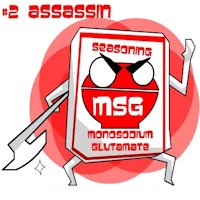
|
Some Common Myths Thought to be True - Myth 24
Myth 24: MSG Triggers Migraine Headaches
Monosodium glutamate is the sodium salt of glutamic acid. Glutamate is a
naturally occurring amino acid that is found in nearly all foods, especially
high protein foods such as dairy products, meat and fish and in many
vegetables. Foods often used for their flavoring properties, such as mushrooms
and tomatoes, have high levels of naturally occurring glutamate.
The human body also produces glutamate and it plays an essential role in normal
body functioning.
|
| MSG - Assassin? | |
|
Despite a small number of persons reporting sensitivity to monosodium
glutamate, scientific studies have not shown any direct link between monosodium
glutamate and adverse reactions in humans. Monosodium glutamate used to be
blamed for the "Chinese Restaurant Syndrome" because the first anecdotal report
was made following consumption of a Chinese meal and monosodium glutamate is
widely used in Asian cooking.
|
|
| ⇦ Back to Myth 23 Return to Myth Choices Page 2 On to Myth 25 ⇨ | |